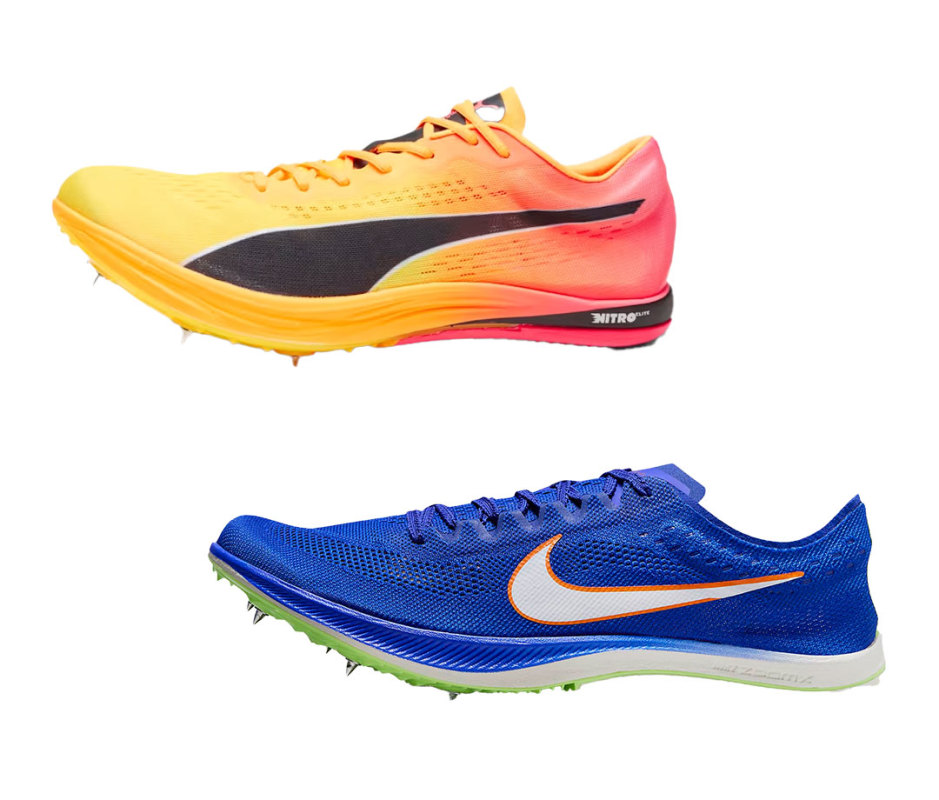Study Confirms These 2 Running Shoes Can Increase Your Speed by 2%
Athletes, especially those at the top, will stop at nothing to improve their performance. Powerlifters use lifting belts to stabilize their spines and some even go as far as to sniff smelling salts before big lifts. Meanwhile, runners have been known to train at elevation to boost VO2 max and fixate on recovery, relying on the best trackers to identify readiness and ice baths to help shunt muscle soreness. Another key? The best of the best running shoes. That includes somewhat controversial running spikes.
Spikes are essential to sprinters’ racing shoes. They help provide grip. They’re considered core to the kit, not contentious. Unless, of course, we’re talking about super spikes.
According to a recent study in the Journal of Sport and Health Science led by the University of Massachusetts Amherst, super spikes can give middle-distance runners an edge of up to 2 percent over their non-spike-wearing counterparts.
Men’s Journal aims to feature only the best products and services. We update when possible, but deals expire and prices can change. If you buy something via one of our links, we may earn a commission.
Related: We Tested 16 of the Newest Brooks Running Shoes. These Are the Best
“Over the past five years many track records have been broken,” says Wouter Hoogkamer, assistant professor of kinesiology at UMass Amherst and senior author of the paper. “Many credit the recent developments in spike technology for this, but scientifically, we don’t know that they help. Are athletes running faster because the spikes are faster, or just because they are training better or run on faster tracks?”
Running spikes are designed to help runners run faster. They are lighter weight than other running shoes and help runners (especially sprinters and middle-distance runners) gain greater traction. They are said to have originated in the late 1800s by Reebok founder Joseph Williams Foster, but didn’t become mainstream until athletes like Jesse Owens and Harold Abrahams wore them to the Olympics in the mid 1900s.
“Super spikes have a thicker yet lighter, more resilient and compliant midsole, often combined with a stiff-carbon-fiber plate embedded in the midsole,” said Montgomery Bertschy, a doctoral student in Hoogkamer’s UMass Integrative Locomotive Lab and joint first author of the paper.
While super spikes can be used by any runner, they’re most commonly utilized by serious sprinters. However, Hoogkamer and Victor Rodrigo-Carranza, a then-graduate student at the University of Castilla-La Mancha in Spain, wanted to quantify their benefits in middle-distance track events.
Related: We Tested Every Running Shoe Asics Offers. These Are the Best
To determine whether super spikes really are the cause of faster running and more broken records Hoogkamer and colleagues compared different designs of super spikes with a traditional track spike.
They then asked athletes to run a series of 200m intervals at self-perceived middle-distance race pace, a common workout for middle-distance runners.
“Our results also indicate that, over a 1,500m race, our participants would take 17 to 21 steps less in super spikes as compared to traditional spikes,” says Hoogkamer.
So, not only did the use of super spikes help runners improve their cadence, but it also helped them run faster overall. So, which super spikes reigned supreme?
Researchers found PUMA evoSPEED LD Nitro Elite+ and Nike ZoomX Dragonfly resulted in an improved running speed of about 2 percent (ranging from anywhere from 1.8 percent to 3.1 percent).

Courtesy Images
Related: We Tested Dozens of Trail Running Shoes. These Are the Best for Rocky, Uneven Terrain

